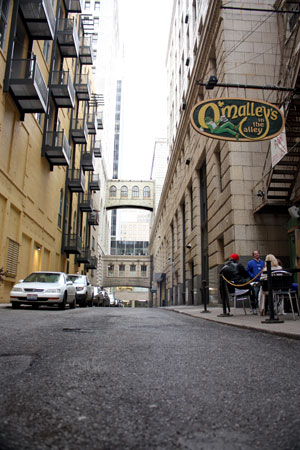An oft-overlooked part of Cincinnati's, or any city's, urban core is the network of alleys that weave in and out of its main streets. These narrow paths primarily represent critical access points to hard to reach locations, service points for utility companies, and locations for trash pick-up outside of the public eye, but they also present an interesting opportunity for use or reuse in cases where they have become functionally obsolete.

The latter is the case in many older neighborhoods around the city including historic Over-the-Rhine. At one point in time, OTR's alleys provided critical access and had a functionality in everyday life, but presently many of the alleys have suffered from a lack of maintenance of everyday use.
The result has been the closure of alleys with gates and fences to privatize the space for access to new residences.
In Philadelphia's downtown, alleys act much more as a secondary element of the city. Along the primary roads, grand entrances to major office buildings and chain tenants take up the street-level spaces of the buildings and capitalize on the heavy traffic count passing by on a daily basis. The alleys offer a place for small local shops to open, and a space for bicyclists, and more often, pedestrians to navigate the urban landscape without the danger of speeding automobiles.
Cincinnati Acting City Architect Jack Martin stated that alleys make up roughly 5 to 10 percent of the surface area over Over-the-Rhine and the Central Business District. This means that not only do the alleys represent a large street-level space footprint, they also represent a large floor footprint that is often damaging to water runoff systems.
As a result, the City has begun
greening the alleys by reusing the clay bricks in many of the alleys as part of a pervious pavement system that stores water runoff and releases it into the ground once it is able to absorb the water naturally.
Elsewhere business and community leaders have suggested a variety of purposes for underused alleys in these high land value areas. Some ideas include the closure of the alleys to vehicles so that they can instead be used solely for pedestrian purposes or even open container areas such as the proposal for alley ways in the Backstage Entertainment District in downtown.
Meanwhile the alleys in the more heavily residential Over-the-Rhine neighborhood have had more difficulty in determining potential reuses. The trend, as it currently exists, seems to be continued privatization, but a future network of bicycle paths might very well prove to be fruitful for the neighborhood as primary streets become increasingly more congested with vehicles.
Writer:
Randy A. SimesPhotography by Tiffani FisherStay connected by following Randy on Twitter
@UrbanCincy
Enjoy this story?
Sign up for free solutions-based reporting in your inbox each week.